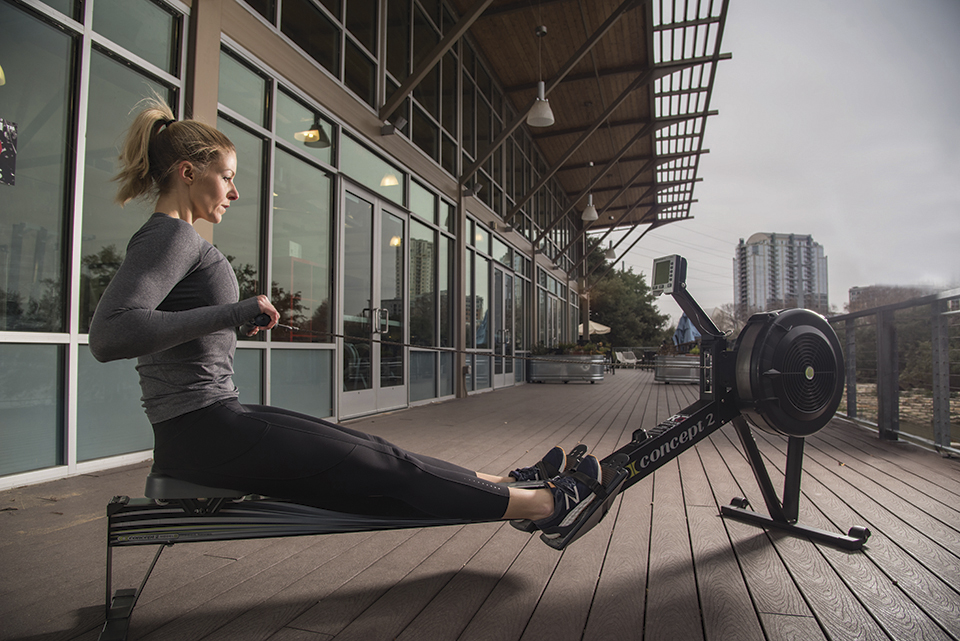The Right Cardio for Your Goals

.jpg)
SHOT ON LOCATION AT WILD HEART YOGA
It seems like there’s a new gym offering some type of cardio workout opening up on every corner of Austin these days. And why shouldn’t there be? Everybody benefits from cardiovascular exercise. From a health and general fitness standpoint alone, some cardio should always be done. The difference in the program design will be in duration, frequency, and intensity levels to suit your goals.
When it comes to cardio workouts, most people are doing them for the purpose of losing weight (specifically shedding body fat) and getting in better physical shape. Most people are not using cardio to train for an endurance sport and are not endurance athletes—so for the sake of brevity, I’ll assume that you, AFM reader, are like most people looking for the best way to use cardio to get the results you want. For cardio, I urge clients to join a group fitness program since there is an added element of accountability and community. Too many gym memberships go unused once motivation starts to wane. If you have a support system in place, you’re more likely to stick with it for the long haul.
Looking at what Austin currently has to offer, here are some of the best cardio group classes for overall fat loss and improved fitness in my opinion as a fat loss expert.
Keep in mind that cardio is only one piece of the fitness puzzle, no matter what your goals may be. Your nutrition, resistance training, flexibility, and rest and recovery are also equally important regardless of your specific goals. So, make sure your fitness regimen is balanced.
If your goal is to improve endurance and overall fitness, try….
Moderate Intensity Cardio 2-3 Times/Week
Indoor cycling, indoor rowing, Pilates/yoga/barre boot camps, traditional aerobics, dance workouts, and kickboxing are all moderately intense cardio. These classes are basically 30–40 minutes of work where your heart rate stays elevated at a fairly constant level after the warm-up and before the cool-down. You typically don’t need much rest or recovery in between these workouts.
Check out Austin originals RIDE Indoor Cycling, Ro Fitness, MOD Fitness, Ballet Austin, Tetra Fitness, Pure Austin Fitness, Castle Hill, and Love Cycling for plenty of these cardio options and check the schedules at your favorite yoga, barre, or Pilates studio for “boot camp” style classes.
.jpg)
If your goal is to hit maximum calorie burn in minimal time and you only have a few days a week to exercise, try…
Higher Intensity Cardio
Many outdoor boot camps, “express format” interval classes, and classes that combine traditional cardio with resistance training in one session would fall into this category. These programs are a little more intense and are designed to spike and lower the heart rate to increase post workout calorie burn through EPOC (Excess Post-Exercise Oxygen Consumption, which is simply continued energy burned after the workout). The only downside to this type of cardio is that if you’re doing it correctly as designed, you will need to let your central nervous system recover a bit between workouts, just like you do from weight training or HIIT. One to two sessions a week is great for most people. If you’re doing this type of cardio 3–5 times a week and don’t find it to be challenging, that’s a sign that you need to increase your output—maybe perform those burpees a little faster, eh?
Check out Austin originals FIT Austin, Crush Fitness, Level Interval Training, Heat Boot Camp, Fuerte Fitness, Relentless Boot Camp, and Stronghorn Fitness.
.jpg)
If your goal is to shed body fat while maintaining muscle mass, or if building strength is your primary fitness goal, try…
HIIT
HIIT or high-intensity interval training, is so challenging by nature that it can’t last more than 10–20 minutes. A good example of HIIT is running sprint repeats. The interval should be intense, but repeatable with consistent effort. Your rest should based on the time it takes for your heart rate to come back down. These nuances make HIIT a very difficult type of cardio to offer in a group setting. Some classes claim “HIIT” benefits when they really are high intensity cardio instead.
The best way to get your HIIT training in, is to take it on solo or with a partner whose effort you’re not trying to match. It’s you versus you here. Hit your local high school track. Jog once around the track (400m); then, starting at the top of a straightaway, run as fast as you can until the track curves (100m). Walk slowly back to the starting point and wait until you are rested and your heart rate has come back down before you repeat the sprint interval (it helps to wear a heart rate monitor, but you can use the old school pulse point method). Start with 3–5 of these intervals, trying to match your effort each time. As you progress, you can shorten the rest time between intervals (it won’t take you as long to recover), add repetitions, shorten the distance and increase speed, and increase the distance. If you’re doing this on a treadmill or the road, you can also progress by adding incline or finding a hill.
Best tools for HIIT: If you’re not a runner, you can do HIIT with your body weight or on cardio machines at the gym like rowers, airdynes, spin bikes, treadmills, and Jacob’s Ladders—or use tools like battle ropes, kettlebells, and jump ropes. The idea is to use these tools to help you reach maximum output. You’re likely to never reach maximum output on the elliptical or recumbent bike for example. Most folks will only need to do 1–2 HIIT sessions a week to reap the cardiovascular benefits from this type of exercise. Plan to do HIIT on a non-strength training day if you want to incorporate this into a strength building routine.
.jpg)






